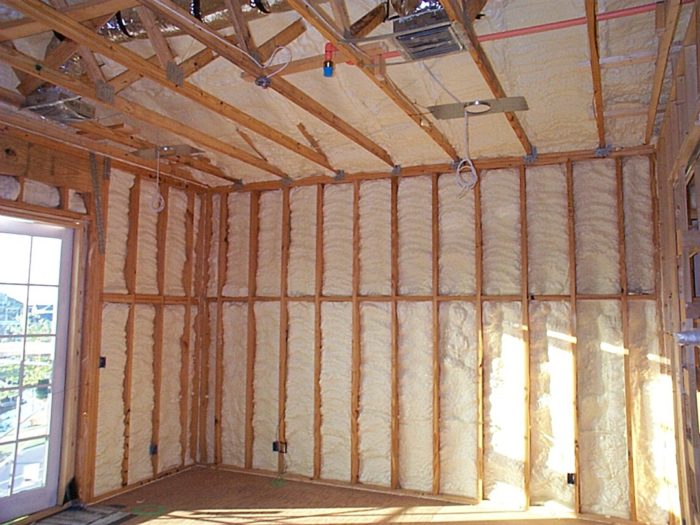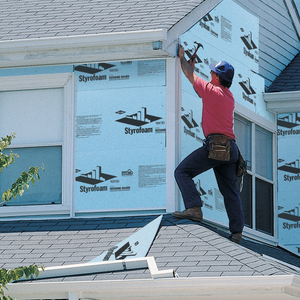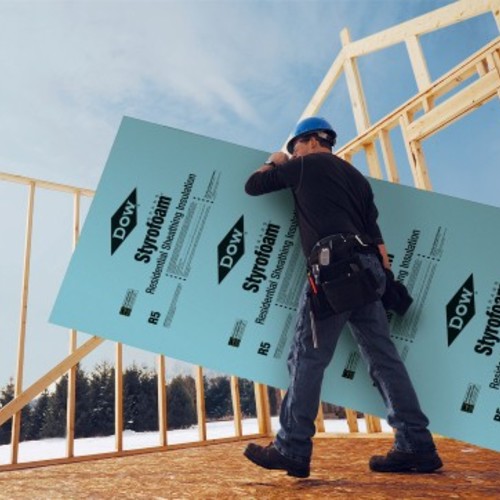
Image Credit: National Renewable Energy Laboratory
UPDATED on Feb. 9, 2017
Reformulated versions of spray polyurethane foam with only a tiny fraction of the global warming potential of their predecessors are getting easier to find.
Texas-based Demilec, a manufacturer with distribution in both the U.S. and Canada, is among those offering a medium-density closed-cell spray foam made with a hydrofluoroolefin (HFO) blowing agent, the next generation of chemistry for the industry. Similar products are here or on the way.
Blowing agents are essential ingredients in spray foam insulation. They create the tiny bubbles of trapped gas that slow the movement of heat and make foam such a good insulator. But the most common blowing agent in spray polyurethane foam today, a hydrofluorocarbon, has a global warming potential (GWP) more than 1,000 times that of carbon dioxide. The HFO Demilec and others now offer — a chemical made by Honeywell called Solstice Liquid Blowing Agent — has a GWP of 1.
Demilec’s Heatlok XT HFO enters the market three years ahead of a federal ban on HFC 245fa, the blowing agent that’s now used in most brands of closed-cell spray polyurethane foam. The high GWP of hydrofluorocarbons is one reason some builders flatly refuse to use spray foam, despite its superior insulating and air-sealing characteristics.
Tom Harris, Demilec’s vice president for building science and innovation, said that Heatlok XT HFO is available nationally, although the spray foam will come at a slightly higher cost than foam made with HFCs.
Demilec is one of several companies in the U.S. and Canada switching to Solstice LBA. A list provided by Honeywell also includes Lapolla (Foam-Lok 2000-4G); Elastochem Specialty Chemicals , a Canadian company marketing Insulthane Extreme; SES Polyurethane Systems; Covestro; Accella Polyurethane Systems; NCFI Polyurethanes; and Henry Co.
However, product details were not available for all of them, and not all of the manufacturers currently have medium-density versions of the foam for insulating wall and roof cavities in houses.
Higher cost, better performance
Harris said the new spray foam has several advantages over products made with HFCs. One is an increase in the maximum thickness of each layer, or “lift,” of foam that can be applied without the risk it will catch on fire.
Spray foams are mixed on site in an application gun. The ensuing chemical reaction is exothermic — producing heat as well as the characteristic foam. If the foam applied in a single pass is too thick, the chemical reaction can generate so much heat that it catches on fire. Typically, spray foam can be applied in lifts of a couple of inches, but Harris said XT HFO can be applied 6 1/2 inches thick in a single pass.
The HFO-blown foam also has high R-values: R-6.3 per inch when measured in a 2-inch thick layer, but R-7.4 per inch at a depth of 8 inches, Harris said. The “stacked R-value” is higher, he said, because the thermal resistance of a thicker layer of foam is not linear — it adds up faster than a simple multiplication of its 1-inch R-value would suggest.
Contractors who have used the foam say it handles better than HFC-blown version; it has less of a tendency to “stick in the gun,” which reduces the number of times a gun must be cleaned during the day, according to Harris.
The transition has been slow
Moving from one blowing agent to another is a painful process for manufacturers. Although Honeywell intended Solstice as a drop-in replacement for HFC 245fa, it apparently hasn’t been that simple.
“To change a blowing agent, it’s a several year process,” said Rick Duncan, technical director for the Spray Polyurethane Foam Alliance, an industry trade group. “They have to reformulate their B side and retest all their products in the field, and redo all the fire testing. It costs hundreds of thousands of dollars to do that, and usually a couple of years.”
Of the 20 or so major U.S. producers of spray foam component chemicals, what the industry calls “systems houses,” only a few are known to offer HFO-blown foam with a density of 2 lb. per cubic foot — the type of closed-cell foam used in wall and roof cavities. NCFI and Henry Co. have HFO-blown 3-lb. spray foam, the type used on roof exteriors, but not 2-lb. versions.
NCFI senior product manager Jason Hoerter said the company is working on a medium-density HFO formulation but isn’t quite ready to roll it out. “I would hope by the end of the year,” he said, “if not sooner.”
Lapolla and Elastochem advertise 2-lb. versions on their websites. But product details from the other companies listed by Honeywell were harder to come by.
Everyone will have to make the switch eventually, however. Neither Harris nor Duncan think that the change of guard in Washington, with new leadership in the White House and at the EPA, will affect the 2020 deadline currently on the books.
In the meantime, do builders really care? Some obviously do, but the clamor for more environmentally benign blowing agents seems to have fallen off in the last few years, Harris said.
Part of the reason is that HFC-blown foam still meets the letter of the law, and because of that there isn’t the pressure from building owners and product specifiers for newer versions. Plus, insulation contractors can be wary of experimenting with a new product that hasn’t been used much in the field, what Harris calls the “comfort factor.”
“The conversation about environmental impact has waned a bit in the last few years,” he said. “That’s too bad, but it will change again. The industry has been through this transition many times. We wanted to be in front of the curve.”
Harris said he expects Demilec, which for now still offers at HFC-blown version, to be “100% HFOs” by the end of this year.
Honeywell says interest is growing
Honeywell said through a spokeswoman that spray foams formulated with Solstice LBA have “grown tremendously” over the last year.
“The conversion to Solstice LBA systems [is] being seen in both residential and commercial markets,” the company said. “Over 30% of the systems houses have adopted Solstice systems well ahead of regulations. Why? Because the systems have better performance and are better for the environment. We are consistently seeing improved thermal performance and yields up to a 10 percent improvement.”
One concern with contractors will be cost, but Honeywell said the impact should actually be minimal even if the price of the blowing agent itself is a little higher.
“The superior performance in thermal performance and yields will make these systems cost-neutral to the contractor on an installed basis,” the spokeswoman said in an email.
The company also asserts there has been an “uptick” in the demand for products with a better environmental footprint, not the waning of interest Harris mentioned.
No matter what blowing agents are used for the spray foam, some builders and designers are likely to stay away from the insulation. 475 High Performance Building Supply, for example, is a proponent of foam-free construction. The firm argues against foam on a number of grounds, including the toxicity of its ingredients and the danger it poses in the event of fire. Like-minded designers and builders would rather specify a material like cellulose or mineral wool and stay away from insulation based on petrochemicals.
This post was updated on Feb. 9 with new information provided by Honeywell
Weekly Newsletter
Get building science and energy efficiency advice, plus special offers, in your inbox.















13 Comments
Also change in EPA phaseout schedule
The initial EPA schedule for HFC phaseout had omitted a schedule for spray foam because it seems more complicated and harder than the other uses. As of Sept. 2016, they published a new revision of the rule that phases out some HFC spray foam by Jan 1, 2020, and others by Jan 1, 2021. As I understand it, the 2020 deadline is for the type used by spray foam contractors, and the 2021 deadline is for the small 2-part kits that are sold for DIY use for the general contractors to use for a small area application. That change in the rule had escaped my attention and I don't think I've seen it mentioned here on GBA.
It's interesting that different parties report different levels of interest. Part of that can be attributed to the attempts of the manufacturers to hide the issue until they have products ready to address it. Once they have products that can address it, and they update their web sites and literature to reflect that there's a major environmental drawback to the standard product, and that there's a better product available, I'm sure the level of interest will be much stronger than it was until now, when they did their best to hide the issue.
In any case, it's great to hear that Demilac has joined Lapolla in having a product available, and that the others will soon.
The XPS industry is lagging, but at least we have other options like EPS and neopor to substitute there.
Stacked R Value
Ignoring what might be going on at the boundaries or the temperature dependence of the material's thermal conductivity, can someone help me understand "stacked R value"? Is it possible that its thermal conductivity is also a function of distance? That would be interesting.
Nonlinear R value
I'm curious about the physics of the nonlinear R value. In fluffy insulation, that can be the result of large-scale convection loops, but that would go the other way: lower R per inch in a thicker sample.
One possibility is that the foam actually cures differently in different thicknesses, and a 1" thick slice of the thick foam would in fact have the same R-value per inch as the thick foam.
There's also the fact that the HFO diffuses out more slowly in a thicker sample, so the thicker section would retain its initial R-value longer. Perhaps they are comparing R-values of different thicknesses after limited aging time. If that's what it is, after enough aging time, the thick foam would settle to the same R-value per inch as the thinner foam.
Response to Charlie Sullivan
Charlie,
I tend to be skeptical of these R-value claims. In an interview I conducted with building scientist John Straube, Straube told me, "You know, installers of closed-cell spray foam sometimes brag, ‘We’re spraying foam at R-7 an inch.’ Maybe it’s R-7 instantly, right after you spray it, but after just a little bit of aging, you won’t getting anything near that. We’ve never seen any foam that achieves R-7. You may be spraying it, but it doesn’t make it to my lab. Lots of people make claims but no one is checking. Who is the consumer watchdog?"
That said, perhaps this new type of spray foam has an R-value that is unprecedented. We'll see.
-- Martin Holladay
More on R-value
I asked Tom Harris at Demilec which ASTM test procedure was used to arrive at R-7.4 per inch. His response was: ASTM C518.
My first thought is whats the
My first thought is whats the rate of gas loss, if its R7/inch today how about 10 years from now, and 50 years from now and even 100 years from now.
Second thought what is the blowing agent that has a GWP value of exactly 1.
Response to Alan B
Alan,
If spray foam manufacturers ever found a way to use CO2 (carbon dioxide) as a blowing agent, then they would be able to brag that their blowing agent has a global warming potential of 1.
Even better is a blowing agent with a global warming potential of zero. As far as I know, some spray foams offered by Icynene use water as the blowing agent. So for these types of spray foam, the GWP of the blowing agent is closer to 0 than 1.
--Martin Holladay
I always worry about installer error when it comes to foam.
Rectifying installer error of spray foam is a PITA and potentially very expensive.
CO2 as a blowing agent
"If spray foam manufacturers ever found a way to use CO2 (carbon dioxide) as a blowing agent, then they would be able to brag that their blowing agent has a global warming potential of 1."
European XPS has been blown primarily with CO2 for something like a decade or more now. The primary down side is the severe marketing problem that it's thermal performance is identical to EPS (~R4.2/inch), which makes it difficult to sell it at a premium price.
It has different compression & water vapor permeance characteristics than EPS though, which makes a difference in some applications.
Thanks, Dana
Dana,
I appreciate the information on rigid foam blown with CO2. After I read your comment, I realized that I should have remembered that fact. Thanks.
-- Martin Holladay
Does this concern apply only to closed cell spray foam?
Re: Open cell spray foam: Is there any concern with blowing agents with open cell? Other than cost, is there any other concern or downside to using open cell?
Re: Closed cell spray foam: What is the best way to locate a foam subcontractor using HFO's (ilo HFC's)? If closed cell will no longer be a global warming problem if sprayed with HFO's, is there any other downside to closed cell? Since it has higher R value, is there any chance it will start to be used in applications that currently use open cell (ie exterior walls, etc.)
I am really interested in the answer to the question about closed cell contractors (in the greater Boston area) that use a low GWP blowing agent. I am trying to figure out how to insulate a basement fieldstone foundation wall that is very rough and out of square. All solutions seems to involve at least some amount of closed cell foam.
Most foam manufacturers have a contractor-finder contact page on their websites. It helps to know the product name of the HFO blown product, since most still have a mix of HFC and HFO blown products.
Log in or create an account to post a comment.
Sign up Log in